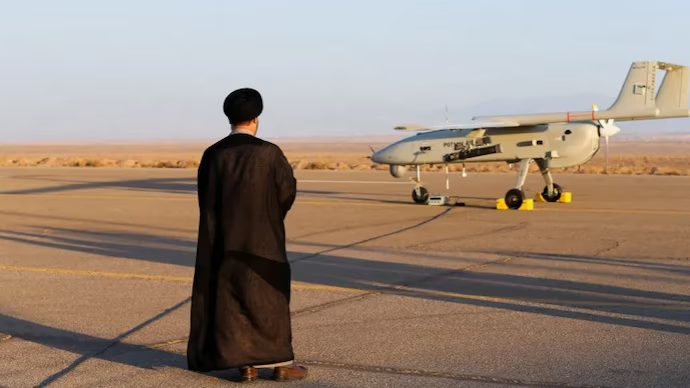The evolving landscape of terrorist threats has seen a disturbing rise in the use of drones for attacks, which has now extended to targeting high-profile leaders. The recent attempted attack on Israeli Prime Minister Benjamin Netanyahu’s residence by a Hezbollah-sent Iranian drone is a stark reminder of the capabilities and intent of such non-state actors. This incident, though foiled, has sent shockwaves through global security circles, raising critical questions about the preparedness of countries like India, which faces a constant threat from its hostile neighbors and terrorist groups.
Hezbollah’s Drone Attack: A Wake-up Call
The Hezbollah drone sent to attack Netanyahu highlights a dangerous trend—the increasing reliance on advanced drone technology by terrorist organizations. Drones are favored for their cost-effectiveness, ease of acquisition, and difficulty in detection, especially when compared to traditional methods of carrying out attacks. These drones can be used for reconnaissance, smuggling, or direct attacks, capable of carrying explosives to precisely target locations.
While Hezbollah’s drone arsenal has long been known to include Iranian-made drones, this recent attempt shows how they can bypass some of the most sophisticated air defense systems. The implications for India are severe, as the country faces similar threats from groups such as Jaish-e-Mohammed (JeM) and Lashkar-e-Taiba (LeT), both of which have access to state-sponsored drone technology from Pakistan and other adversaries. The borders with Pakistan and China are already hotspots for drone activity, with regular reports of drone sightings used to drop arms and narcotics into Indian territory.
Threats to Indian Leadership: A Looming Danger
For India, the threat of drones targeting its leadership is more real than ever before. The Prime Minister, key ministers, and high-profile figures are symbolic targets for terrorist organizations looking to strike a blow at the nation’s heart. Given the increasing drone activity in Jammu and Kashmir, Punjab, and the Northeast, it is crucial to recognize that political and military leaders could be next on the hit list.
A drone attack could take place during public events, large political rallies, or even at highly secure locations like government buildings or official residences. As seen with the Hezbollah attack, terrorists could launch drones from considerable distances, making it difficult to preempt the attack. The relative anonymity of drone operations, with no direct physical presence required, compounds the complexity of tackling this threat.
Steps India Should Take
To counter this growing danger, India must strengthen its security infrastructure with a comprehensive and multi-pronged approach. Here are the key steps India should urgently consider:
- Develop Advanced Anti-Drone Technology
India needs to invest heavily in indigenous anti-drone technologies, including drone jammers, radar systems, and directed energy weapons (DEWs). Several countries, including Israel and the U.S., have developed technologies that can disable or destroy drones before they reach critical areas. India’s Defence Research and Development Organisation (DRDO) has made some headway in developing anti-drone systems, but much more needs to be done to keep pace with the evolving drone threat. - Strengthen Air Defense and Surveillance Systems
Drones are often difficult to detect due to their small size and ability to fly at low altitudes. India must enhance its air defense systems to include more sophisticated drone detection and neutralization mechanisms. Installing high-tech radar systems, optical sensors, and continuous surveillance drones around key government buildings and residences is essential. - Create No-Fly Zones and Geo-Fencing
Implementing stricter regulations on no-fly zones around critical infrastructure is a must. Geo-fencing technologies can ensure that drones are automatically blocked or disabled from flying near sensitive locations, including airports, government buildings, and residences of political leaders. There is a need to enforce these regulations not only in the capital, New Delhi, but across all major Indian cities. - Coordinate with Private Sector and International Partners
The development of anti-drone technology should not be limited to government agencies alone. India should collaborate with the private sector, particularly tech companies with expertise in AI, cybersecurity, and UAV technologies, to create solutions tailored to Indian security needs. Additionally, Israel, the U.S., and France, which have significant experience in tackling drone threats, can be valuable partners in sharing intelligence and counter-drone technology. - Counter-Terrorism Intelligence Upgradation
Strengthening intelligence networks to identify potential drone threats before they materialize is critical. Indian intelligence agencies must work closely with international partners to track the movement of drones and UAV technology in regions such as Iran, Pakistan, and Afghanistan, where terrorist organizations may acquire or develop such capabilities. - Tighten Regulations on Drone Usage
In addition to defense measures, India must update its drone regulations to limit the civilian use of drones, especially around sensitive areas. The Directorate General of Civil Aviation (DGCA) has taken some steps to regulate drone usage, but these efforts need to be further tightened, with strict penalties for violations. - Mass Awareness Campaigns
Given that many attacks could involve small drones operated from civilian areas, there must be increased public awareness about the responsible use of drones and how to report suspicious drone activity. Such campaigns should target both urban and rural areas, particularly near sensitive installations.
Conclusion
The attempted drone attack on Israeli leadership is a stern warning to India of the emerging challenges posed by terrorist drones. As terrorist groups acquire more sophisticated drone technologies, the Indian government must take immediate, decisive steps to safeguard its leadership and critical infrastructure. With a blend of advanced technology, international cooperation, and stricter regulations, India can significantly reduce the risk of drone-based terrorist attacks and ensure the safety of its political leadership. The nation must remain vigilant and proactive, treating the drone threat as one of the highest security priorities.






